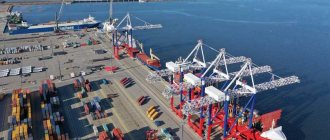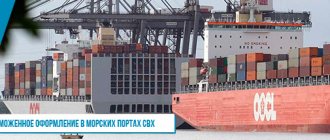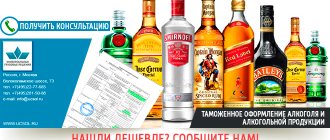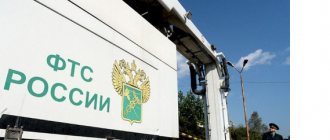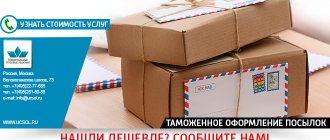- Customs structure
- Customs legislation
- Customs clearance of goods
Customs is a government body that is responsible for the movement of any goods, be it commercial consignments, vehicles or personal items across the customs border. Each product, depending on its type or purpose, is subject to certain customs procedures: customs transit, release for domestic consumption, export, re-export and others. Currently, the legislation provides for 17 types of such procedures. All of them are listed in the Customs Code of the EAEU (Eurasian Customs Union).
The global tasks of customs are to protect the economic interests of the country and assist in ensuring state and public security measures. Within the framework of these tasks, the main functions of customs can be identified:
- Control of trade turnover across the state border and creation of optimal conditions for doing business for participants in foreign economic activity.
- Collection of legally required duties and taxes.
- Combating smuggling and illegal trafficking of weapons, drugs and other prohibited substances.
- Interaction with customs authorities of other states, maintaining statistics, informing and consulting the population on customs issues, etc.
IT IS IMPORTANT TO UNDERSTAND that no matter how customs declare their functions, the main one has always been and remains the fiscal function, in other words, the priority for customs is activities related to replenishing the Federal budget.
In addition, when we talk about customs, we mean by this term CUSTOMS AUTHORITIES, since all functions are performed by customs officials, and customs is an integral part of the structure of the customs authorities of the Russian Federation.
But for convenience, the term “customs” is used in the literature for the average user.
Customs structure
The official name of Russian customs is the Federal Customs Service of Russia (FCS). Like any government agency, the Federal Customs Service is a centralized system and consists of a number of divisions:
- Central office. The core of the federal customs service. It is subordinate to the Ministry of Finance of the Russian Federation. It consists of many departments: organizational and inspection, customs clearance and control, anti-smuggling, etc. Geographically located in Moscow.
- Regional customs departments - one for each federal district. There are eight of them in total.
- Customs. Subordinate to regional customs departments. As a rule, they are located in large cities and monitor the activities of customs posts with established regional activities.
- Customs posts. It is at the posts that the operations of documentary customs clearance and actual customs control are directly carried out.
In turn, customs posts are divided into:
a) border guards who are at checkpoints on the borders with other states.
b) internal ones, which are not tied to checkpoints.
Also, customs posts specialize by type of transport: road, railway, sea and air. Individual posts have the status of legal entities, their own current accounts and a wider range of powers.
Customs legislation
Russia is a member of the Eurasian Economic Union (EAEU), which also includes the Republics of Belarus and Kazakhstan, Kyrgyzstan and Armenia. Customs officers act in accordance with the provisions of the EAEU Customs Code, which came into force on January 1, 2021. Previously, it was replaced by the Customs Code of the Customs Union, and even earlier - by the Customs Code of the Russian Federation. Both documents have already lost force.
The EAEU Customs Code provides for a unified procedure for the movement of goods across the borders of the union member states. Its entry into force made it possible to optimize most customs procedures, taking into account the absence of customs borders between these states. However, state borders between them have not been abolished.
In particular, instead of written declaration of goods, electronic declaration is used, which significantly reduces the time for processing declarations and releasing goods for free circulation. Written declaration is relevant only for some customs procedures - for example, placing cargo under customs transit.
Certain provisions of customs legislation are regulated by the Federal Law “On Customs Regulation” No. 289-FZ, which details and explains certain provisions of the EAEU customs code in relation to the customs authorities of the Russian Federation.
These are the two main regulations in the field of customs.
Recently, in light of the entry into force of the new Customs Code of the Eurasian Economic Union, customs authorities began to pay close attention to the labeling of imported goods for compliance with the Decision of the Customs Union Commission No. 711 of July 15, 2011 (as amended on March 17, 2016) “On a single sign of product circulation on the market of the Eurasian Economic Union and the procedure for its application,” which, as it turns out, can serve as a serious obstacle when importing consignments of goods into the territory of the EAEU, even if the importer has all the required documents.
Let's figure out what labeling requirements a product must meet in order to smoothly pass through customs control.
According to paragraph 2 of Appendix 9 of the “Protocol on technical regulation within the framework of the Eurasian Economic Union”, the “single mark of product circulation on the Union market” (EAS) is a designation used to inform purchasers and consumers about the compliance of products released into circulation with the requirements of the technical regulations of the Union.
Thus, products that have passed the conformity assessment procedures established by the technical regulations of the Union are subject to mandatory marking with a single sign of product circulation on the Union market.
So far, everything seems to be clear. Problems, as always, begin when interpreting the provisions of paragraphs 2 and 5 of the decision of the Customs Union Commission No. 711. Thus, the first of them states that “Marking with a single circulation mark is carried out before releasing products into circulation on the market of the Eurasian Economic Union,” and in accordance with clause 5.1 “A single circulation mark is applied to each unit of product, packaging or accompanying documentation.”
According to one of the representatives of the expert community, all markings that comply with the requirements of the EAEU must be applied before the products are released into circulation, which for imported goods means “before importation”, but, firstly, the simultaneous presentation to the customs authority of a document of conformity in which the identification features of the product (brand, article, model, manufacturer), completely identical to the information about the product indicated on the product itself and/or in the documents for the product, means compliance with the requirements of customs legislation on documentary confirmation of compliance of goods with the requirements of technical regulations. Secondly, customs authorities do not have the authority to check the validity of issuing a document of compliance and/or carry out any actions to verify the actual compliance of goods with the requirements of technical regulations.”
Based on the above, many participants in foreign economic activity have questions for the customs authorities about how its employees, based solely on the fact of the lack of proper labeling, draw conclusions about the non-compliance of imported goods with safety requirements, despite the fact that the presence of a certificate of compliance issued in accordance with the procedure established by law indicates exactly the opposite.
Judicial practice on such issues is very contradictory. And if in some cases the courts side with the importer and agree that checking the application of the EAC mark on products when making a decision on the release of products does not fall within the competence of the customs authority, then at the same time there are already overturned decisions taken by higher courts , considering the conclusion that the customs authorities lack the relevant competence is incorrect (for example, the resolution of the Arbitration Court of the Central District dated June 30, 2021 in case No. A62-5236/2015).
As for applying the EAC marking itself to goods, our company received an official response from the legal service department of the Central Customs Administration. According to it and in view of the fact that “a single circulation mark indicates that the products marked with it have passed all the conformity assessment (confirmation) procedures established in the technical regulations of the Eurasian Economic Union (technical regulations of the Customs Union) and meet the requirements of all those applying to these products technical regulations of the Eurasian Economic Union (technical regulations of the Customs Union)” “it is necessary to be guided by the provisions of each specific technical regulation regarding the labeling of products with a single sign of circulation on the market of the Union member states.”
So, for example, the technical regulations of the Customs Union “On the safety of machinery and equipment”, which came into force on February 15, 2013, state that:
- Machines and (or) equipment that comply with the safety requirements of the Technical Regulations and have passed the conformity assessment procedure must be marked with a single circulation mark.
- Marking with a single circulation mark is carried out before the release of machines and (or) equipment into circulation on the market.
- A single circulation mark is applied to each unit of machinery and (or) equipment in any way that provides a clear and distinct image during the service life of the machine and (or) equipment.
Regarding the issue of applying a single circulation mark on the product itself
it is indicated that it is allowed to apply a single circulation mark only to the packaging and attached operational documents, if it cannot be applied directly to the machine and (or) equipment. Machines and (or) equipment are marked with a single circulation mark if they comply with the requirements of all technical regulations of the Union that apply to them and provide for the application of a single circulation mark.
If the importer intends to import a batch of children's toys
, falling under the technical regulations of the Customs Union “On the safety of toys”, adopted by the Decision of the Commission of the Customs Union dated September 23, 2011 No. 798 (hereinafter referred to as TR CU 008/2011) and, accordingly, a unified mark for the circulation of products on the market of the Union member states “applied directly on the toy itself and (or) the packaging of the toy (individually, group, transport) and (or) label, medallion, tag, including a sew-in label), insert sheets, and is also given in the operational documents attached to it.” For toys consisting of several parts, a single sign of product circulation on the market of the Union member states is applied to those parts that can be placed on the market separately.
When importing food products
The department of the legal service of the CTU refers to the provisions of the Decision of the Customs Union Commission dated December 9, 2011 No. 881 “On the adoption of the technical regulations of the customs union “Food products in terms of their labeling” (hereinafter referred to as TR CU 022/2011) in accordance with which “labeling of food products - this is information about food products applied in the form of inscriptions, drawings, signs, symbols, other designations and (or) their combinations on consumer packaging, transport packaging or other type of information carrier attached to consumer packaging and (or) transport packaging, or placed in them or attached to them.” According to subclause 1.11 of clause 4.1 of Article 4 of TR CU 022/2011, the labeling of packaged food products must contain, among other things, a single mark for the circulation of products on the market of the member states of the EAC Union.
When importing perfumery and cosmetic products
importers should be guided by the provisions of the Technical Regulations of the Customs Union “On the safety of perfumery and cosmetic products” (hereinafter referred to as TR CU 009/2011), adopted by the Decision of the Customs Union Commission dated September 23, 2011 No. 799. According to Article 7, labeling with a single mark for the circulation of products on the market of the member states Union is carried out before the release of products into circulation on the market. A single sign of product circulation on the market of the Union member states is applied to each unit of product (consumer packaging, tag, label) and/or shipping documentation.
As can be seen from the above examples, the use of the “and/or” construction allows for unclear interpretation. Thus, it is impossible to predict whether marking only on the packaging of the toy or on the packaging and the toy itself will be sufficient for smooth release.
One thing is certain - the number of interpretations and related disputes, litigation and administrative protocols will not decrease in the near future. In this situation, the appeal of importers to experienced customs market professionals can help them successfully overcome difficulties associated with product labeling and other requirements imposed by customs authorities on imported goods.
| Requirements for product labeling | Furniture labeling requirements | Requirements for marking machinery and equipment |
| Requirements for marking and operational documents | General requirements | Food industry labeling requirements |
Customs clearance of goods
YOU SHOULD KNOW that all goods transported across the customs border of the EAEU (including the Russian Federation) are subject to customs clearance. This procedure is also called customs clearance. Its procedure is regulated by the norms of the Customs Code of the EAEU and provides for a strictly defined set of actions that differ depending on the customs procedure. For example, when importing goods from abroad, customs clearance primarily includes declaring the cargo - filing a Declaration of Goods. The entry into force of the EAEU Labor Code made it possible to simplify this stage as much as possible - many companies submit declarations online independently, using an electronic digital signature. Control of the declaration takes place in several stages:
- Control of the classification code of goods in accordance with the Commodity Nomenclature of the EAEU.
- Control of non-tariff regulatory measures - permitting procedure for the import of goods (compliance of goods with established Technical Regulations, phytosanitary control, veterinary control, licensing, etc.)
- Determination of the customs value of the goods, it serves as the basis for calculating all taxes and duties.
- Payment of customs duties.
- Release of goods into free circulation. It is after this decision is made by a customs official that the owner of the goods can dispose of the cargo without restrictions throughout the entire territory of the EAEU.
It should be noted that customs operations in relation to goods under customs control can be carried out by persons who have the right of ownership (property) in relation to goods, called DECLARANTS (or their authorized representatives located in their state). In the absence of special knowledge to carry out customs operations, primarily declaration, such actions are carried out by legal entities specially authorized by the state - CUSTOMS REPRESENTATIVES, the list of which can be clarified on the official website of the Federal Customs Service.
Features of vehicle declaration
There are certain features of customs declaration of international transport vehicles. Like any product imported into Russia, a car must undergo a customs clearance procedure, which includes correctly filling out a declaration, it must indicate the details of the vehicle owner, all information about the car, including year of production, brand, engine size and number, VIN number . One copy of the declaration remains with the owner. Next, the inspector is provided with accompanying documents for the vehicle, including a purchase and sale or delivery agreement, an invoice, specifications for new equipment, and an invoice for transport services. After this, the vehicle is inspected, payments are made and the car is released from customs. If the inspector finds any violations or inaccuracies, the car is sent to a special parking lot until the comments and errors in the TD are eliminated.
Customs clearance of parcels
When crossing borders, customs clearance of any parcel or product is carried out without exception. Often, many do not even suspect that their parcel has passed customs; as a rule, this happens without the participation of the recipient. An employee of the authorized service checks what the shipment contains using an X-ray, looks at the documents and, if everything matches, releases the goods into the country. You can see the status in the delivery tracking program or on the seller’s website in your personal account “customs clearance has begun.” The procedure lasts no more than 24 hours if correct passport data was provided and no other comments were found.
When ordering goods on foreign websites, when tracking delivery, you can see the status “customs clearance error” - what does this mean? This means that the parcel was detained at customs. This occurs for a number of reasons: incorrectly filled out documents or their absence, no information about the sender, the parcel contains products prohibited for import, the price of the goods does not correspond to the market value (underestimated), suspicion of using the goods for commercial purposes. If you have any questions about parcel delays, you should contact the customs service directly to clarify additional information.
The MV-Trade company regularly carries out customs clearance of cargo and goods. We know the legislative framework, monitor its relevance, navigate complex issues of customs clearance and customs clearance of products, and take into account all the nuances. To carry out successful customs clearance, contact MV-Trade specialists by phone numbers listed on the website, or leave your contact information in the form below. We will call you back shortly.

